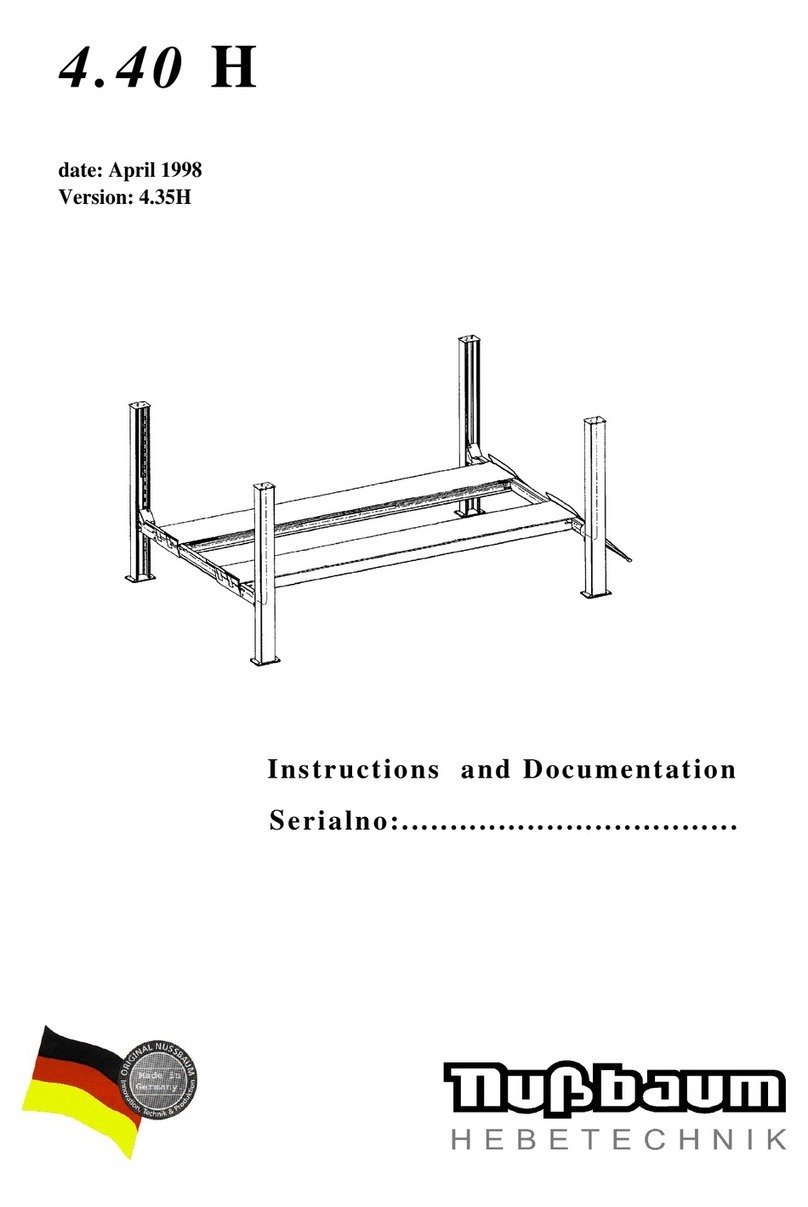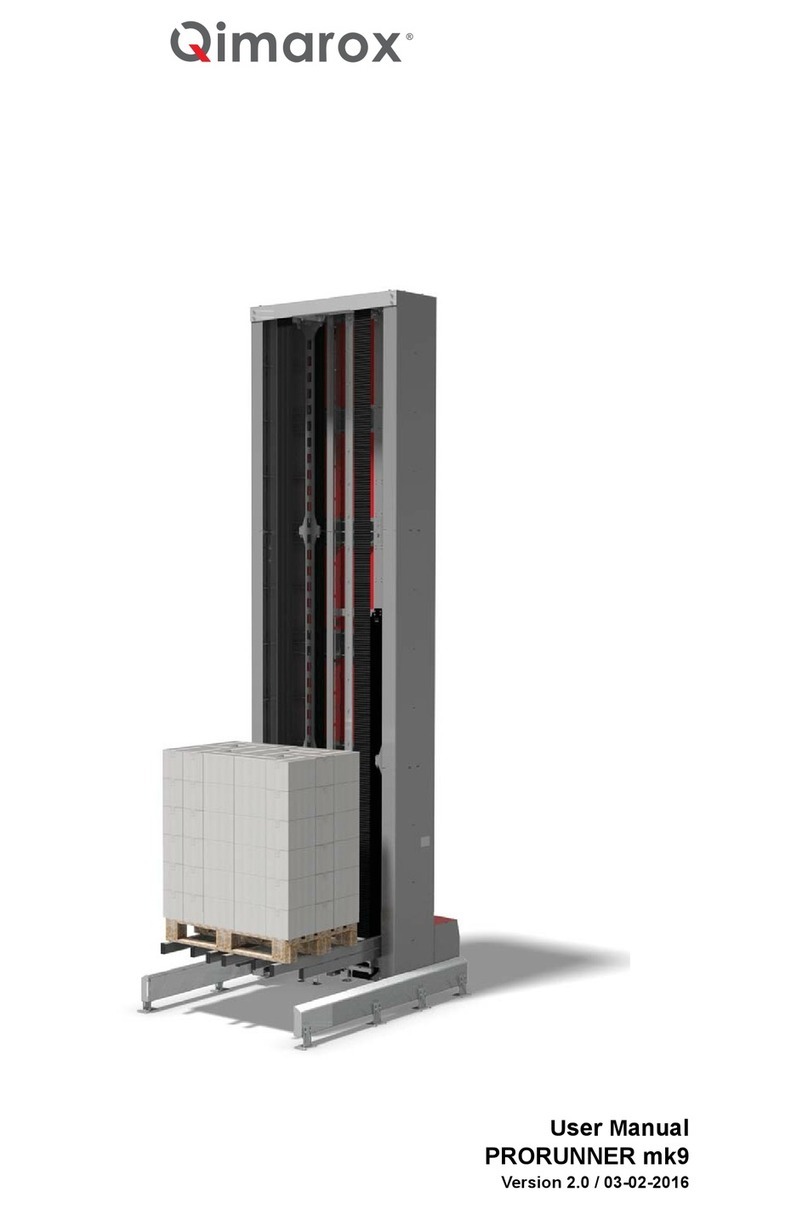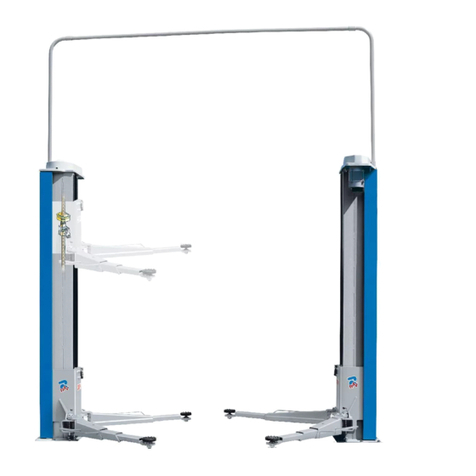Nußbaum Hebetechnik 2.30 SL E Operator's manual

2.30 SL E
Automotive Lift date: 10-2000
Manual date: 06.10.2000
Version: electronic
Operating Instruction and Documentation
Serial-number:........................................................
Nußbaum Hebetechnik GmbH & Co.KG//Korker Strasse 24//D-77694 Kehl-Bodersweier//Tel: +49(0)7853/8990
Fax: +49(0)7853/8787//E-mail: info@nussbaum-lifts.de//http://www.nussbaum-lifts.de
Retailer address /Phone

Operating Instruction and Documentation
2.30 SL E
- 2 -
Table of contents
Foreword................................................................................................................................................ 3
1. Introduction............................................................................................................................................. 5
2. Master document of the lift..................................................................................................................... 6
2.1 Manufacturer ................................................................................................................................... 6
2.2 Application....................................................................................................................................... 6
2.3 Changes of construction................................................................................................................... 6
2.4 Changing of the installation place ................................................................................................... 6
2.5 CE-certificate/attestation of conformity.......................................................................................... 7
3. Technical Information............................................................................................................................. 8
3.1 Technical ratings.............................................................................................................................. 8
3.2 Safety devices.................................................................................................................................. 8
4. Safety regulations.................................................................................................................................... 9
5. Operating instructions.............................................................................................................................. 10
5.1 Positioning the vehicle..................................................................................................................... 10
5.2 Synchronism of the automotive lift.................................................................................................. 10
5.3 Lifting the vehicle............................................................................................................................ 11
5.4 Lowering the vehicle........................................................................................................................ 11
5.5 LED display visibly at the operating unit......................................................................................... 12
6. Maintenance............................................................................................................................................ 14
6.1 Maintenance schedule of the automotive lift................................................................................... 14
6.2 Adjust of the polyflex-belt............................................................................................................... 15
6.3 Check the carrying nut system......................................................................................................... 16
6.4 Check of the stability of the automotive lift.................................................................................... 16
7. Troubleshooting....................................................................................................................................... 17
7.1 Emergency lowering in case of power failure.................................................................................. 18
7.2 Driving onto an obstacle.................................................................................................................. 18
7.3 Function of safety device................................................................................................................. 18
7.4 Manually equalisation of the lifting carriage................................................................................... 19
7.5 Adjusting of the “Limit switch“...................................................................................................... 19
8. Installation and Initiation......................................................................................................................... 20
8.1 Installation of the automotive lift..................................................................................................... 20
8.1.1 Erection and doweling of the lift............................................................................................. 20
8.1.2 Electro mounting and current connection................................................................................ 22
A) with using ascending pipe and traverse................................................................................. 22
B) without using ascending pipe and traverse............................................................................ 23
8.1.3 Installation the carrying arms........................................................................................................ 23
8.2 Initiation........................................................................................................................................... 24
8.3 Changing the installation place........................................................................................................ 24
9. Security check.......................................................................................................................................... 24
Appendix
Datasheet..................................................................................................................................................... 26
Foundation plan (version with traverse and ascending pipe)...................................................................... 28
Foundation plan (version without traverse and ascending)......................................................................... 29
Block foundation plan (with ascending pipe and traverse)......................................................................... 30
Selection of dowels (with floor covering)................................................................................................... 31
Selection of dowels (without floor covering).............................................................................................. 32
Electrical diagram drawing Part 1............................................................................................................... 33
Electrical diagram drawing Part 2............................................................................................................... 34
Record of installation................................................................................................................................... 35
Record of handing over............................................................................................................................... 36
Document "First security check before Installation"................................................................................... 37
Document "Regular security check"........................................................................................................... 38
Document "Extraordinary security check".................................................................................................. 45

Operating Instruction and Documentation
2.30 SL E
- 3 -
Foreword
Nussbaum-Lifts are a result of long-standing experiences.
The high quality and the superior concept guarantee them reliability, a long lift time and the
economic business.
To avoid unnecessary damages and dangers, read the operating instruction attentive and
observe the contents.
Another or the described purpose going out use is not valid when not as agreed.
This is valid particularly for climb and go.
Company Nussbaum is not liable for damages arising from this. The user carries the risk
alonely.
For the use belonged:
- to observe all the notice in the operating instruction and
- the following of the inspection and maintenance work and the prescribed tests.
- The instruction for use have to be observed by all persons working with the lift.
- Especially the chapter “Safety/accident Prevention“ has to be observed.
- In addition to the safety remarks of the instructions for use the regulations and
instructions being valid at the place of operation have to be considered.
Obligations of the operator:
The operator is obliged to allow only those persons complying to the following requirement to
work at the unit
- being well acquainted with the basic regulations concerning labour safety and accident
prevention and being trained to operate the unit.
- having read and understood the chapter concerning safety and warning instructions and
confirmed that by their signature.
Dangers when operating with the lift:
The Nußbaum-Lifts are designed and built according to technical standard and the approved
regulations for technical security. Yet, danger for body and life of the operator may turn up
when using the lift inexpertly.
The lift must only be operated :
- for its appropriate use
- in unobjectionable condition concerning technical security.

Operating Instruction and Documentation
2.30 SL E
- 4 -
Organising requirements
- The instructions for use are constantly to be kept at the place of operation being at hand
at any time.
- In addition to the instructions for use rules pertaining to other regulations i.e. accident
prevention and environmental rules are to be observed and directed.
- Safety- and danger alert operation of personal is occasionally and by observing the
instructions for use to be controlled.
- As far as required and ordered by regulations personal protective equipment is to be
used
- All safety- and danger-hints at the lift are to be observed!
- Spare parts must comply with technical requirements laid down by the manufacturer.
This is only warranted with original parts.
Consider time intervals given or fixed in instructions for use for repeated
tests/inspections.
Maintenance works, remedy of faults and disposal
- Fixed Adjusting-, maintenance- and inspection works and time intervals including
Details for exchange of parts/part components as mentioned in the instructions for use
are to be adhered.
These works must only be carried out by expert personal.
- After maintenance- and repair works loose screw connections must always be firmly
tightend!

Operating Instruction and Documentation
2.30 SL E
- 5 -
1.Introduction
The document ”Operating Instructions and Documentation” contains important
information about installation, operation and maintenance of the 2.30 SL E/T/MB.
To furnish proof of installation of the automotive lift the form ”Record of Installation”
must be signed and returned to the manufacturer.
To furnish proof of the singular, felt this documentation contains forms. The forms should
be used to document the checks. They should not be removed from this documentation.
Every Changes to the construction and displacement of the automotive lift must be
registered in the ”Master document” of the lift.
Installation and check of the automotive lift
Only specialist staff is allowed to do work concerning safety and to do the safety checks of
the lift. They are called experts and competent person in this document.
Experts are persons (for example self-employed engineers, experts) which have
received instruction and have experience to check and to test automotive lifts.
They know the relevant labour and accidents prevention regulations.
Competent person are persons who have acquired adequate knowledge and experience
with automotive lifts. They took part in training from the lift-manufacturer
(servicing technicians of the manufacturer or dealer, are competent)
Information of Warning
To show danger and to show important information the three symbols below are used. Pay
attention to those passages, which are marked with these symbols
Danger! This sign indicates danger to life. Inexpert handling of the described
operation may be dangerous to life.
Caution! This sign cautions against possible damage to the automotive lift or
other material defects in case of inexpert handling .
Attention! This sign indicates for an important function or other important
notes.

Operating Instruction and Documentation
2.30 SL E
- 6 -
2. Master document of the automotive lift
2.1 Lift –manufacturer Otto Nussbaum GmbH & Co.KG
KorkerStraße24
D-77694 Kehl-Bodersweier
Germany
2.2 Application
The automotive lift 2.30 SL E is a lifting stage for lifting and repairing vehicles with a
laden weight of 3000 kg. It is not allowed to put the load on one or two carrying arms.
It is not allowed to install the standard lift in the a explosive location or wash halls.
After changing the construction and after repair, the lift has to be checked by an expert
again. The operating instruction and the instruction for maintenance have to be observed.
Changes at the construction, repairs and transposement of lift must be registered
in this master document.
2.3 Changes at the construction
Changes at the construction, expert checking, resumption of work (date, kind of
change, signature of the expert)
..................................................................................................................................................
..................................................................................................................................................
..................................................................................................................................................
..................................................................................................................................................
name, address of the expert
........................................................... ............................................................
place, date signature of the expert
2.4 Displacement of the automotive-lift
Displacement of the automotive-lift, expert checking, resumption of work (date, kind
of change, signature of the competent)
..................................................................................................................................................
..................................................................................................................................................
name, address of the competent
........................................................... ............................................................
place, date signature of the competent

Operating Instruction and Documentation
2.30 SL E
- 7 -
2.5 CE-Certificate/attestation of conformity
The automotive lift 2.30 SL E with the serial number.............................................................
Is in accordance with the tested lift (CE-certificate-number 04-205-2563/96)
................................................ ...............................................................
place, date company stamp, signature

Operating Instruction and Documentation
2.30 SL E
- 8 -
3. Technical Information
3.1 Technical ratings
Lifting capacity
2.30 SL E 3000 kg
Load of one carrying arm max. 1000 kg (It is not
allowed to put the load on one
or two carrying arms.)
Lifting time approx. 40 sec.
Lifting height max. 1870 mm
Line voltage 3 x 400 three phase current
Power rating 2 x 1,5 kW
Motor speed 1420 rotation/speed
Sound level ≤75 dB(A)
Connection by customer Fuse T16 A / 5x 1,5 qm²
in accordance with
recommendation
3.2 Safety devices
1. safety switching in case the carrying nut breaks
2. limit stop switch (actuated by electronic control)
3. foot protector
4. synchronism controlled by electronic control system

Operating Instruction and Documentation
2.30 SL E
- 9 -
4. Safety regulations
Using automotive lifts for working the Regulations of Accident Prevention (VBG1:
General Regulations, VBG14: Automotive lifts) must be observed.
Especially the following regulations are very important
• During working with the lift the operating instructions must be followed.
• The laden weight of the lifted vehicle mustn’t be more than 3000 kg for automotive lift
2.30 SL E , the lifting capacity of one carrying arm mustn’t be more than 1000 kg. It is
not allowed to load only one of the carrying arms.
• Only trained personnel over the age of 18 years old are to operate this lift.
• During lifting or lowering the vehicle it must be observed from the operator.
• Position the pads as described of the vehicle manufacturer under the vehicle.
• Observe the complete lifting and lowering.
• Switch on and switch off the main switch, so that the lifting and lowering movement is
steady and not abrupt.
• It’s not allowed to stay under the lifted or lowered vehicle (except for the operator).
• It’s not allowed to transport passengers on the lift or in the vehicle.
• It’s not allowed to climb onto the lift during lifting or lowering or onto a lifted vehicle.
• The Automotive Lift must be checked from an expert after changes in construction or
after repairing carrying pads.
• It’s not allowed to start with operations at the lift before the main switch is switched off.
• It’s not allowed to install the standard-automotive lift in hazardous location.

Operating Instruction and Documentation
2.30 SL E
- 10 -
5. Operating instructions
The Safety Regulations must be observed during working with the automotive lift.
Read the safety regulations in chapter 4 carefully before working with the lift!
5.1 Positioning the vehicle
• Drive the vehicle in the lift. Observe the following pictures A and B.
pic. A) the column must be between the pic. B) drive the vehicle in the centre of
steering wheel and the car-door. the lift.
• Position the adjustable pads under the vehicle which are described by the vehicle
manufacturer. (see pic.1)
pic1:
Position the pads under the described
points of the vehicle.
• The fixing device of the arms must lock.
• Check the pick up points if the lift is repeatedly lowering in the lowest position.
• Control the dangerous places of the lift and be sure that there are no objects or
people in the immediate area of the lift or on the lift.
5.2 Synchronism of the automotive lift
• The lift is equipped with an electronic synchronism.
• At the two columns are potentiometer which recognition the actual-Position of the
spindle. They recognition the height of the lift.
• A lifting carriage is faster like the other lifting carriage. The electronic control
system sees the process and stopped the fast carriage so long until both carriage
have the same height again. The permitted regulation range is 18 mm

Operating Instruction and Documentation
2.30 SL E
- 11 -
5.3 Lifting the vehicle
• Lift the vehicle free. Check the position of the pads under the vehicle.
• Turn the changing switch in Position „“ until the wheels are free. (see pic 2)
• If the wheels are free stop the lifting and check the sit of the pads again.
Check the pads under the vehicle again, otherwise the vehicle can fall down.
• Lift the vehicle on the working height.
The Lift can during the lifting depending on load repeatedly adjusting.
Check the fixing device of the arms. The device must lock.
pic. 2) the changing switch
5.4 Lowering the vehicle
• Control the dangerous places of the lift and be sure that there are no objects or
people in the immediate area of the lift or on the lift.
• Turn the changing switch in Position „“ (see pic. 2)
• Lower the lift at the height for working or until the carrying arms reach the
lowest position.
The Lift can during the lowering depending on load repeatedly adjusting.
• If the lift is in the lowest position turn the carrying arms to the outside (see D) ,
stop position (C).
C
the Starting point
D
if the lift is in the lowest position turn the carrying
arms to the stop position (starting point)

Operating Instruction and Documentation
2.30 SL E
- 12 -
5.5 LED - (display visibly) at the operating unit
A position measure system observe the lifting and lowering process. Additional the
functions are made by a visibly display. Find the explanations following:
Operating unit at the column
If following LED s are lighten, means this:
OA1- LED red - top limit switch is active (master side)
K1 - LED green - Motor contactor is active (master side)
UA1- LED red – below limit switch is active (master side)
OA2 – LED red – top limit switch is active (slave side)
K2 - LED green – Motor contactor is active (slave side)
UA2 – LED red – below limit switch is active (slave side)
Heben – LED green – the lift is raising
Senken – LED green – the lift is lowering
Indications at standard function
• raising up:
the following LED lighten: lifting, K1,K2 - lowering glow
• lowering:
the following LED lighten: lowering, K1,K2 – lifting glow
• top position is reached (top limit switch is active):
the following LED lighten: OA1, OA2, lifting – lowering glow
• lower position is reached (below limit switch is active):
the following LED lighten: UA1, UA2, lowering – lifting glow

Operating Instruction and Documentation
2.30 SL E
- 13 -

Operating Instruction and Documentation
2.30 SL E
- 14 -
6. Maintenance
A regular service has to be performed every three months by the lifts operator
according to the following schedule. If the lift is in continuous operation or dirty
environment, the maintenance rate has to be increased.
During daily operation the lift has to be watched carefully for its correct function.
In case of any malfunction the technical service of the retailer has to be in formed.
6.1 Maintenance schedule of the automotive lift
d,e,f clean and grease the pull-outs of the carrying arms, bolts of the pads and slide
ways of the carriage sliding blocks.
b Oiling the spindle and the lubricating felt between the carrying nut and the
centring of the spindle one time a month with a thin oil as SAE15W40.
Attaching twice lifting and lowering the lift in the end position. After lifting
and lowering the lift with load.
The lubricating interval has to be carried out at every maintenance. If the lift is
in continuous operation, the maintenance rate has to be increased.
The nut between the column (c) and the covering (g) will greased with an oil
can.
The regular complete lubrication in the mentioned distances
secures the absolutely easy operation for the lift.
Pic.3: lubrication plan
Do not use an biodegradable adhesive oil for greasing the spindle.
A normal adhesive oil impaired the qualities of the lift. We recommend a thin
Oil: for an example SAE15W40.
A over-lubrication or greasing with grease of the spindle through a intensive
lubrication supplies reduce the degree of effectiveness of the lift.
f check the rubber pads, otherwise exchange it.
h grease sequence nut one time a month with multipurpose fat. Use boring at
lifting carriage. (remove the cover)
a grease the spindle bearing annually with multipurpose.

Operating Instruction and Documentation
2.30 SL E
- 15 -
Do not use aggressive means for cleaning the workshop floor and the automotive lift.
A permanent contact with every kind of liquid is forbidden. Do not use any high
pressure device for cleaning the lift.
6.2 Adjust the Polylex-belt
If the belt was exchanged, the belt must be adjusted. Remove the cover of the belt.
(pic.4). Pic.4: cover of the belt (version with raising pipe)
1: column
2: raising pipe
3: cover of the belt
4: spindle
The new belt tension must be adjusted at the stretch device. (pic.5). Loose the three
screws at the motor easily. (pic. 6, No.1). The belt can be loosened or tightened at the
screws. (pic.6, No.2).
Pic.5: position of the belt
1: raising pipe (optional)
2: stretch device
3: V-belt pulley
4: Polyflex-belt
5: shaft of the motor
pic.6: adjust the belt tension
1: the three screws of the motor
2: adjusting screws
The belt tension gets adjusted with the help of an accessory. (pic. 7; This accessory can
be ordered from Nussbaum Hebetechnik (Order number 225SL13000).
Pic.7: accessory

Operating Instruction and Documentation
2.30 SL E
- 16 -
Put the device on a solid flat surface. Push it down until the pin is on the flat surface
too. Put the clock on zero – turn the ring of the clock so long until the indicators are on
zero. Put the device on the V- belt (pic.8, 9). The indicator of the clock may only turn
mini. 1 (1mm) until 1,5 (1,5mm) turn.
Pic.8: measuring instrument
Pic.9: Put the measuring device on the V-belt
• Bring the screws back in initial position.
6.3 Check the carrying nut system
• carrying nut (optical wearing device). To check the carrying nut, take off the
covering of the spindle (pic.3,pos.b). There is a pin built in the carrying plate
(pic.10). This pin must be even with the top edge of the carrying plate (upper side of
the lifting carriage; built-in state pic.11). If the pin looks 2 mm out of the top edge at
the annually check (pic.11 changing state). The carrying nut and the sequence nut
must be replaced.
Pic.10: the carrying-nut pin (stift)

Operating Instruction and Documentation
2.30 SL E
- 17 -
Pic.11: carrying nut
6.4 Check of the stability of the automotive lift
• check the dowels with a torque key as described by the dowel manufacturer.
(example: Liebig Company - 80 Nm )
7. Troubleshooting
If the lift does not work properly, the reason for this might be quite simple. Please check
the lift for the potential reasons mentioned on the following pages. If the cause of
trouble cannot be found, please call the technical service of the dealer.
A simple fault delimitation can be carried out at the LED-display of the operating unit.
(see the step 5.5 LED-Display visibly at the operating unit).
Repairs at the security devices of the lift as well as repairs and examinations
of the electrical fittings are forbidden.
Problem: The lift does not lifting and not lowering!
possible causes: remedying:
the main switch is not switched on switch it on
the main switch is faulty replace it
the fuse is faulty replace it
the feed line is cut replace it
the motor is overheated let it cool down
the plug is not plugged in plug in
the lift is not in the regulation range equalize manually
Problem: The lift does not lifting!
possible causes: remedying:
the lift is running at 2 phases make sure 3 phases by customer
V-belt is torn/slack check it / replace it
the lifting nut is broken call the service partner
top limit is active lower the lift
Problem: The lift does not lowering!
possible causes: remedying:
the bottom limit switch is active raise the lift
lift is driven on a obstacle equalize manually

Operating Instruction and Documentation
2.30 SL E
- 18 -
7.1 Emergency lowering in case of power failure
In case of power failure the lift can not lowered with the motors. In this case there is the
possibility to lower the lift manually. Draw the main plug or switch off and lock the
main switch and remove the cover of the v-belt pulleys. For this the lift must be turned
down to lowest position at the nut on the top end of the spindle. If the lift is in the
lowest position removes the vehicle.
The emergency lowering must only carried out by persons which are
instructed to using the lift. Please refer to the regulation “Lowering the
vehicle”.
Procedure – emergency lowering
• loose the main plug; switch off the main switch and lock it.
• remove the cover of the v-belt pulleys.
• lower the lift: turn the nuts (every side) alternately 5 cm until the lift has reached
lowest position.
• after the emergency lowering: Do not work with the lift until the faulty parts are
exchanged.
7.2 Driving onto an obstacle
If the lifting arm or the lifting carriage is driven on a obstacle, the motor from this side
locked. The lift switched off if the lifting carriage are not more in the regulation range
(approx. 25 – 30 mm) (since 9/99 64 mm).
An additional protection is a temperature control in the motor. Which interrupt the
electrical circuit when it is overloaded. You can not work with the lift. Cool down
approx. 5 – 10 min. dependently on the outside temperature.
After the locking of the motor check the V-belt if necessary replace it. Call the service-
partner.
7.3 Function of safety device
The lift is equipped with a safety switching, which controls the wear of the main nut.
If the lifting nut is broken, a safety nut which is conducted loose in the spindle, carries
the load. After a break of the nut, the lift can only once being lowered in the lowest
position. If the lift has reached the lowest position it is not possible to raise the lift.
The lifting carriage of the broken side gets mechanically locked. During the lifting the
other side is driving out of the regulation range and switched off the lift. You can not
work with the lift anymore. Call the service-partner.
If the safety device is active call the service partner!
Switch off the main switch at all repairs and disturbances!
The electrical system may only be opened by trained persons!

Operating Instruction and Documentation
2.30 SL E
- 19 -
7.4 Manually equalisation of the carriage
The lift is equipped with a position measuring system which guarantee the
synchronisation of the lift. The electrical control recognizes if one lifting carriage is
approx. 18 mm earlier at the definite height. The electrical control stopped the motor of
this carriage until both carriage have the same height again. After it both motors are
working together again.
If the carriages of the lift are driving out of the regulation range/switching off window
of approx. 36 mm (since 9/99 64 mm), the electrical control recognizes this and
switched off the lift.
To reach the normal function of the lift you must equal manually the carriages. Remove
the cover of the V-Belt pulley at the top of the lift. Equal the lift: turn one nut until the
carriage have the same height.
7.5 Adjusting of the top limit switch and the bottom limit switch
The operating unit of the lift is equipped with potentiometer. One is for the top limit
switch and one is for the bottom limit switch. The Potentiometer may from safety
reasons being only adjusted by trained person.
Out of safety reasons: The Potentiometer only may be adjusted by competent trained
persons.
• Pull the main plug before the maintenance or repair.
gic. G
3 Potentiometer for the upper end-point
4 Potentiometer for the lower end-point
It is possible if the adjustments are wrong that the lift has malfunctions. It is
danger for your life for the lift and the vehicle.
• Loose the screws of the operating unit. Pull it careful out of the column. (pic. G)
• If the Potentiometer 3 (top-limit) is turned anticlockwise, the upper end-point has
been moved up. The lift stops later.

Operating Instruction and Documentation
2.30 SL E
- 20 -
• If the Potentiometer 3 (top-limit) is turned clockwise, the upper end-point has been
moved down. The lift stops earlier.
• If the Potentiometer 4 (bottom-limit) is turned anticlockwise, the lower end-point has
been moved up. The lift stops earlier.
• If the Potentiometer 4 (bottom-limit) is turned clockwise, the lower end-point has
been moved down. The lift stops later.
After the adjusting do not lifting or lowering to the end position. The lift can
lock or jamming!
Alter the potentiometer easily. After it operate the lift. Repeat the process
until the normal end position is reached.
• Pay attention at the cover and the rubber behind the operating unit. Do not damaging
this parts. If the parts are faulty replace it. Otherwise the protection (IP54) against
liquids is no more ensured.
8. Installation and Initiation
8.1 Installation of the automotive lift
Regulations for the installation
• The installation of the lift is performed by trained technicians of the manufacturer or
its distribution partner. If the operator can provide trained mechanics, he can install
the lift by himself. The installation has to be done according to this regulation.
• The standard lift must not be installed in hazardous locations or washing areas.
• Before installation a sufficient foundation must be proved or constructed.
• An even installation place has to be provided. The foundations must be based in a
frost resistance depth, both outside and indoors, where you must reckon with frost.
• An electrical supply 3~/N+PE, 400 V, 50 Hz has to be provided. The supply line
must be protected with T16A (VDE0100 German regulation). The minimum
diameter amounts to 1,5 mm².
• The cable entry in the column is located in operating column topside. Another
possibility is the location of the cable entry in a boring at the base plate. However the
cable has to be secured with a cable bushing. Do not fold the cables!
8.1.1 Erection and doweling of the lift
It is necessary to dowel the lift. For this you need a concrete floor with a thickness of at
least 200 mm (150 mm with base plate) and a quality of at least B25. In case of doubt a
test boring has to be performed and a dowel is to set in. Afterwards the dowel is tighten
with a torque which is described of the dowel manufacturer (example: Liebig Company
80 Nm).
If there are defectives (cracks or hairline cracks) in the zone of influence Ø200 mm, the
foundation cannot be used to install the lift on it.
Table of contents
Other Nußbaum Hebetechnik Lifting System manuals
Popular Lifting System manuals by other brands
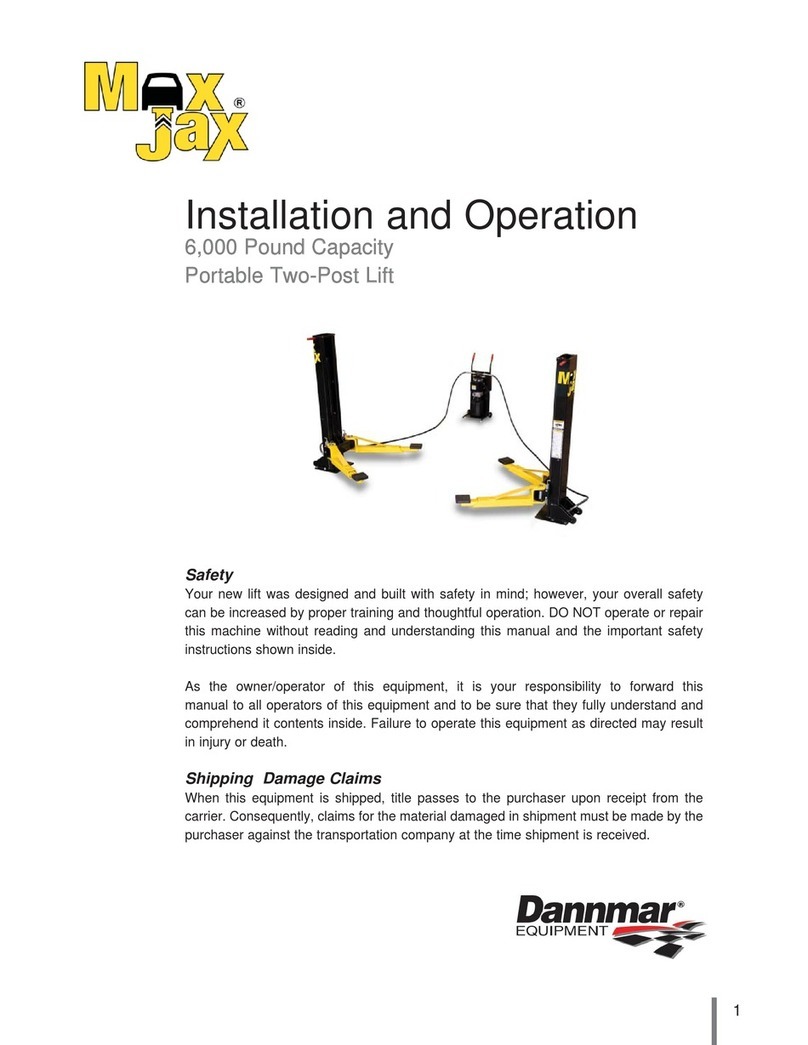
Dannmar Equipment
Dannmar Equipment Max Jax Installation and operation
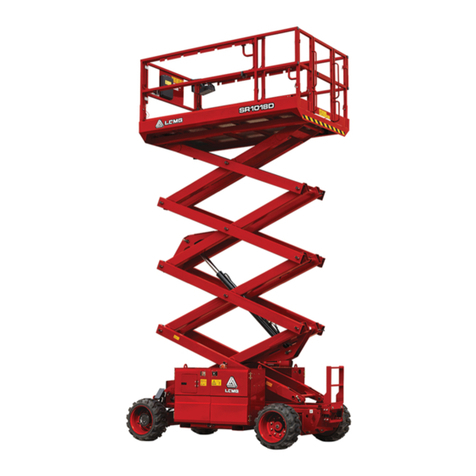
LGMG
LGMG SR1018D Operation manual

Terex
Terex SX135XCH-101 Service and repair manual
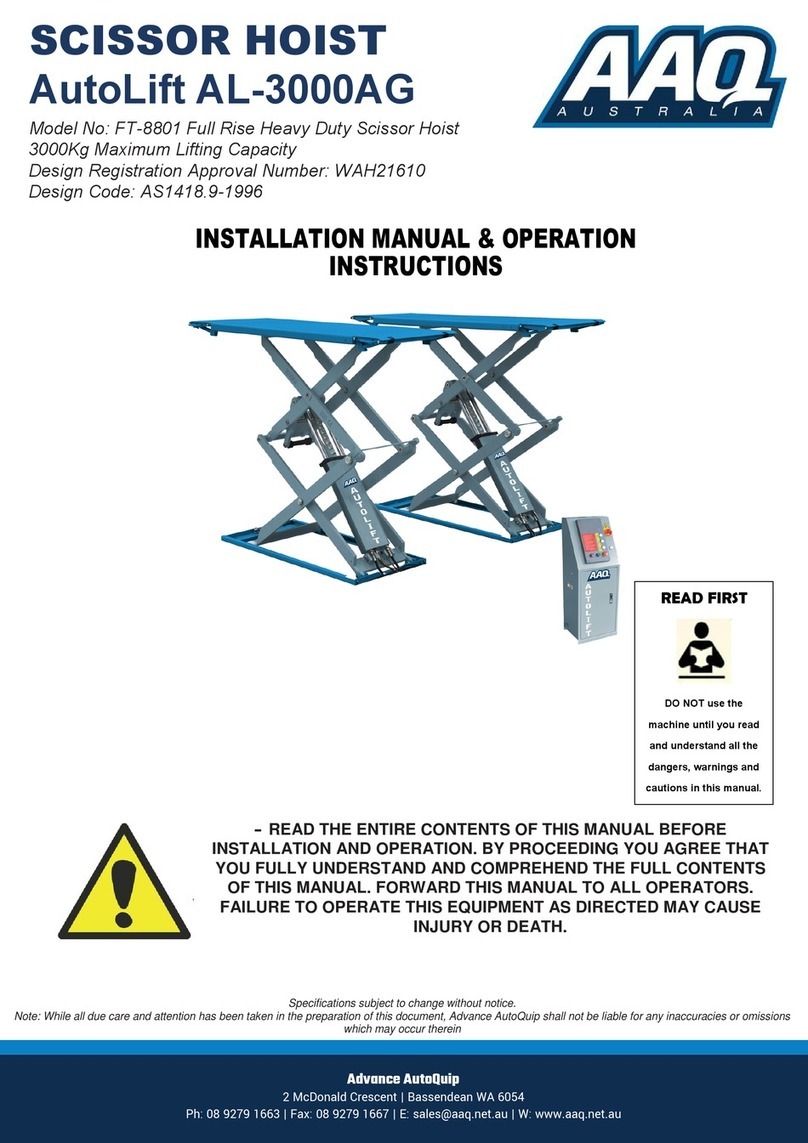
AAQ
AAQ AutoLift AL-3000AG Installation manual & operation instructions
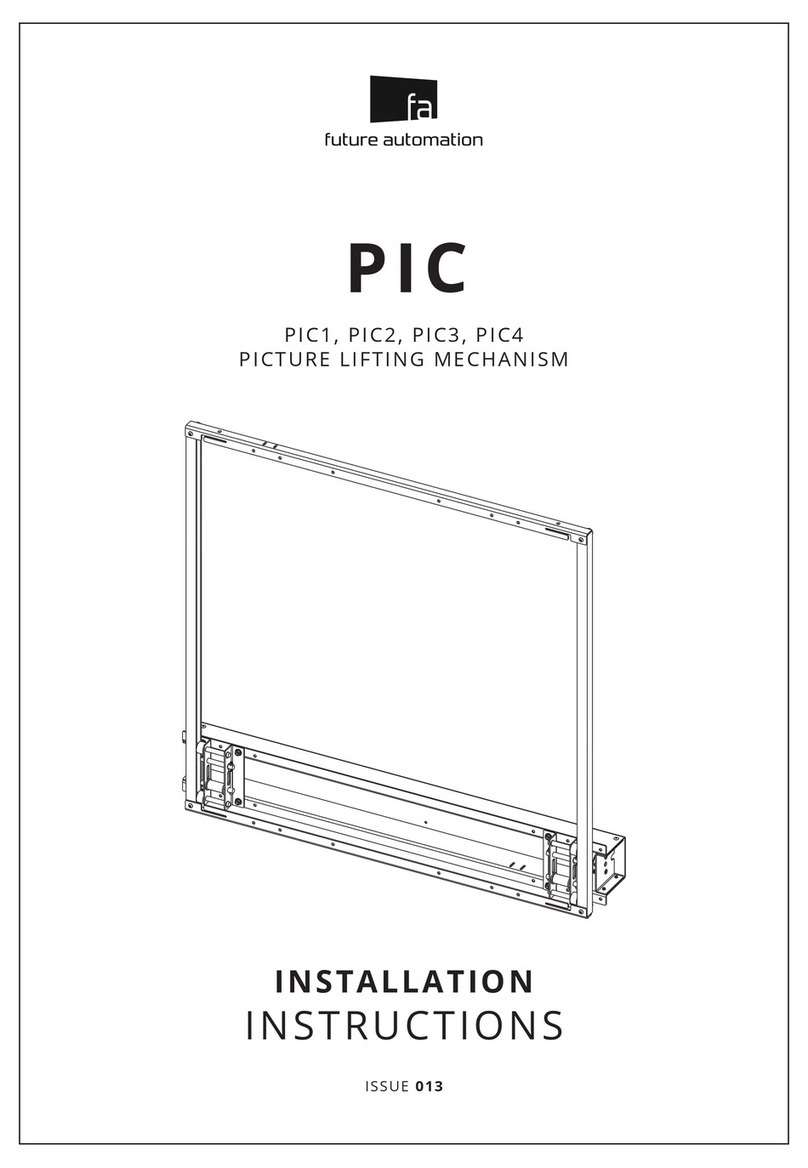
Future Automation
Future Automation PIC Series installation instructions
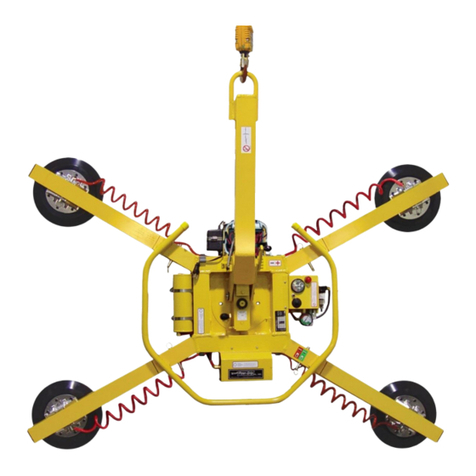
WPG
WPG MRT49DC instructions
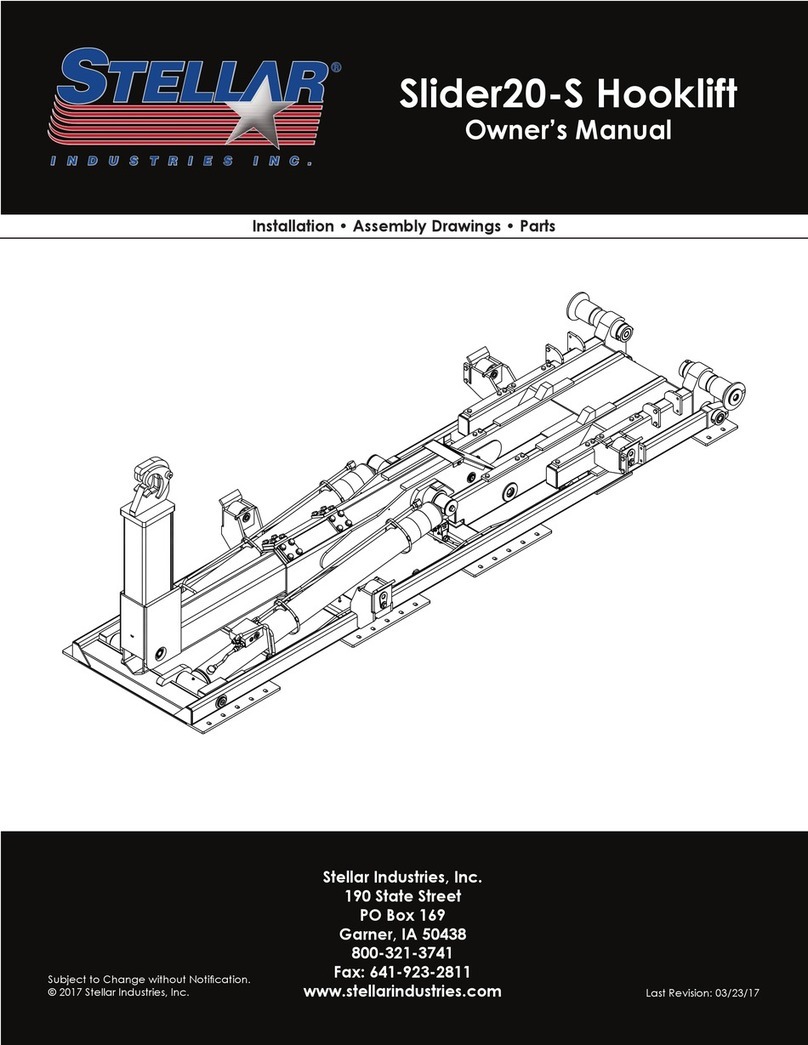
stellar labs
stellar labs Slider 20-S owner's manual
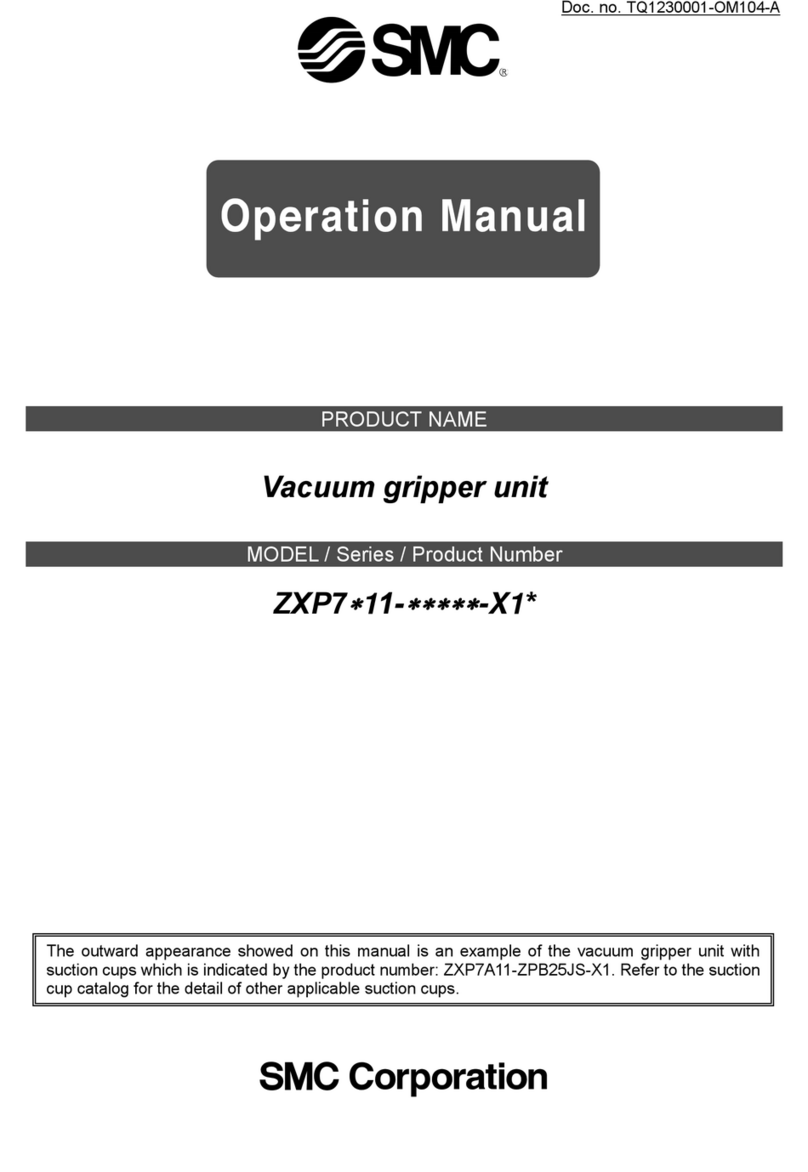
SMC Networks
SMC Networks ZXP7 11-X1 Series Operation manual

AUTEC
AUTEC AL 2520 instruction manual

Tractel Group
Tractel Group jockey Operation and maintenance manual
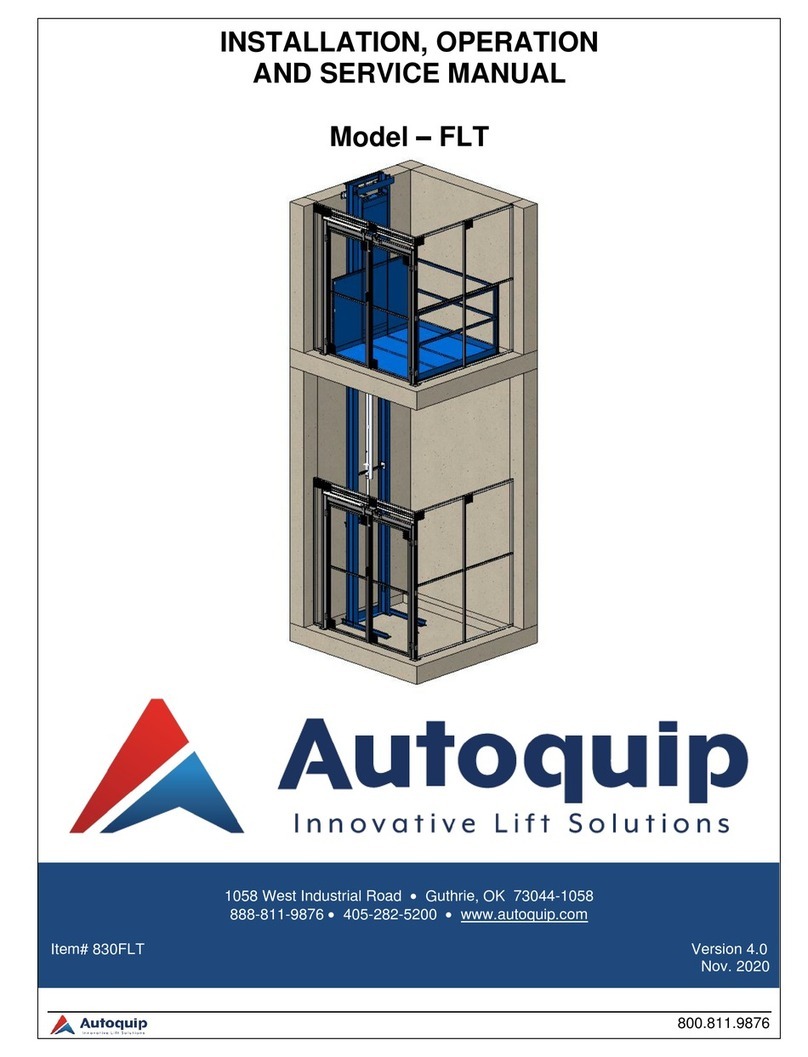
Autoquip
Autoquip FLT Installation, operation and service manual

Peak
Peak Amgo 414A Installation and service manual
